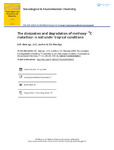| dc.description.abstract | l4C-malathion[S-1,2-bis(ethoxycarbonyl) ethyl O,O-dimethyl phosphorodithioate] has been
studied in soil under tropical field conditions by applying the
14C-malathion pesticide to soil in
Polyvinyl chloride (PVC) pipes and monitoring it with elapsed time. In one area,
14C-malathion
dissipated with a half-life values of 36.7 days and 41 days in the long rain and short rain seasons
respectively. The bound residue of malathion in the soil built up to 51.8% and 73.4% of the
initial pesticide dose in the short and long rain seasons, respectively. However, after sometime
the bound residue decreased and this has been attributed to biodegradation by micro-organisms
in the soil. In another area,
14C-malathion dissipated slowly with a half-life value of 770 days in
the dry spell. The bound residue built up in the soil slowly, attaining a value of 5.49 μg/g
(35.4%) of the initial pesticide dose after 70 days. The bound residues did not decrease at some
stage and this has been attributed to the prevailing dry conditions, which did not promote the
biodegradation of the bound residues in the soil by micro-organisms. The metabolites in the soil
as determined by TLC and confirmed by GC-MS, showed the presence of malaoxon and the
malathion o-mono or β-mono carboxylic acid in addition to the parent compound, malathion. | en_US |

